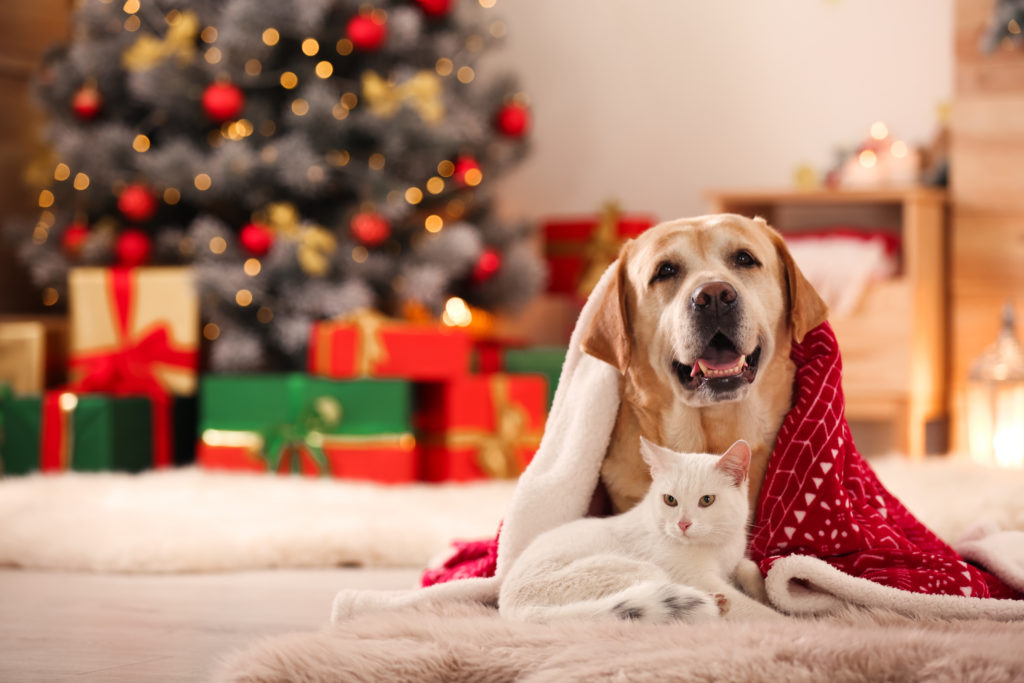Decorating for the holidays is always something to look forward. However, we all must make sure that it is also safe for our furry friends to make sure our holidays are great and we hopefully do not have to take a trip to our emergency vet!
But it’s the holidays, what could really be that harmful? Well, that is a great question so let’s talk about some of these hazards to look out for every year.
The 4 things that can hazardous around the holidays for our best friends are food, decorations, plants, and large gatherings. You maybe wondering how large gatherings have fallen into this category, well read on and let’s find out.
Plants
- Christmas trees are the 1st plant to be aware of and not because it’s toxic. Instead, because our friend always loves the Christmas trees so you want to make sure that they are secured tightly so they’d not fall on your furry friend no matter how big or small! As well, you would not want the tree water to spill where your friend can lick it up as the water can be filled with bacteria that will give your friend an upset tummy or diarrhea.
- Next is Holly & Mistletoe. As we all love some nice holly and mistletoe around the holiday season it is best to make sure it is kept where furry friends can not get it. Holly if ingested can cause nausea, vomiting and diarrhea. Mistletoe, if ingested can cause cardiovascular (heart) problems and gastrointestinal (GI) upset. If you choose to use lilies for anything this holiday, remember that these plants are very toxic to our kitty friends! They can cause them to go into kidney failure. If you want to be safe, you’re better off getting some artificial versions of these plants. Make sure you’re not spending your holidays at your emergency vet.
Decorations
- Tinsel is great, it is so sparkly and jut makes things so much better. Unfortunately, our kitty friends agree! This because a toy cats love to chase and put in their mouths. However, if they play with this and swallow it then you soon have an obstructed GI, severe dehydration, vomiting, and can lead to needing an expensive surgery!
- A cold snowy night, a nice hallmark movie and some hot chocolate. Sounds like the perfect time to turn off the lights and light up the candles. Now there is nothing wrong with this, the issue comes when the candles get left alone. Make sure to always blow out your candles so your friends do not burn themselves or knock them over.
- Wires. This could be electrical wires, ornament wire just about any wire your pet will get curious about. While I do not need to explain why a wire is bad, be it burns to the esophagus or impacting the GI tract, sometimes a little reminder is good for this season.
Food
- So, everyone knows animals can’t have chocolate, but make sure you are also keeping away any sweets with Xylitol in them. However, you may think oh they have been good all year I need not worry, but with the extra food around it can become more tempting than normal. Make sure all garbage is covered, no plates are left unattended, and any leftovers are placed in sealed containers and out of reach.
- The holidays are great for getting together and sometimes having a few adult drinks with friends. Just keep in mind that you should never leave these drinks where your furry friends can try them. If they get in this, they can become very ill, lethargic, and go into a coma resulting in respiratory issues.
Remember, Our furry best friends can not always enjoy the same things as us.
Large gatherings
- Make sure that yours and any of your companies’ medicines are behind closed doors or zipped up and put away and out of reach of our kitties and doggies.
- Make sure there is a nice quiet space for your friends to go be by themselves incase the gathering becomes too overwhelming. No one likes not having a safe space.
- Beware the door! The door itself will do no harm, but this is the time of year that people gather and that door is always opening and closing. This means many more opportunities for our friends to escape outside and get lost. Make sure the door is always closed behind you and that your guests know to not leave it open. Even if they have never tried to go out before, they might with all the new noise and people.
- New Year’s gathering can also be terrifying and dangerous for pets. Confetti string can get eaten and then impact their GI leading to surgery, Noise poppers and be tool loud especially for sensitive ears, and fireworks can be TERRIFYING. Make sure that when it is close to midnight that your friend is in an escape proof room and just be aware of how they are feeling as things happen around them. This being said, if your pet is anxious and needs medications to get through the fireworks, make sure to speak to your veterinarian at least 2 weeks before hand and if you need a refill make sure you call it in at least 2 days before the event. This way you will always be prepared.
You still want to include your friends in this holiday spirit of course so what is the best way?
Honestly, one of the best things to stuff your companions’ stockings are toys that are as indestructible as you can get. Kong is a very good brand for this kind of item and can be stuffed with healthy food and treats! Our smaller kitty friends could get a ball to play with, a small catnip toy, or an interactive cat dancer. The important thing for this season is no string or rope toys as they can obstruct our friends GI tract.
Resources: Veterinary Partner: https://veterinarypartner.vin.com/default.aspx?pid=19239&id=6048033
Written by: Ashley G, VT



